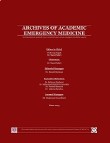Brain Natriuretic Peptides in Screening of Syncope with Cardiac Origin; a Commentary
Author(s):
Article Type:
Letter (دارای رتبه معتبر)
Abstract:
Syncope is a serious problem with life-time prevalence of 35%. It is estimated that 1 -3% of referrals to emergency departments and in-patient admissions are due to syncope. The underlying conditions can be cardiac or neurologic. Considering the completely different circumstances ruling the encounters with cardiac and neurologic syncope, in recent years many attempts have beenmade to find the proper tool for differentiating cardiac and non-cardiac causes of syncope. The result of which is formation of some clinical decision rules including San Francisco Syncope Rule (SFSR), Osservatorio Epidemiologico sulla Sincope nel Lazio (OESIL), Evaluation of Guidelines in Syncope Study (EGSYS), risk stratification of syncope in the emergency department (Rose), and Boston Syncope Rules. The serum marker brain natriuretic peptide (BNP), which is becoming increasingly established in emergency departments for diagnosis of acute heart failure, can reflect the presence of a structural heart disease. It seems that BNP could be considered as a screening tool in detection of syncope with cardiac origin. In a study by Wojtowicz J et al. who evaluated BNP in children and adolescents with syncope, there was no significant difference in terms of BNP level between the syncope and control groups. In contrast, Zhang Q et al. concluded that serum BNP is helpful in differentiating cardiac (958.78 § 2443.41 pg/mL) and non-cardiac (31.05 § 22.64 pg/mL) syncope. Tanimoto K et al. considered the cut-off value of 40 pg/ml for BNP in differentiating cardiac and non-cardiac syncope and found that it had 82% sensitivity and 92% specificity. A significant difference was observed in BNP level of the cardiac group (514 pg/ml) compared to the non-cardiac ones (182 pg/ml) in Pfister et al. study. It seems that, more research is needed to clarify this relationship and the variables that might play the role of confounders in a causal inference.
More studies on children are required because there is some controversy regarding this relationship. Running studies with accurate methodology, large sample sizes, and in a multicentric fashion could be helpful in this regard.
More studies on children are required because there is some controversy regarding this relationship. Running studies with accurate methodology, large sample sizes, and in a multicentric fashion could be helpful in this regard.
Language:
English
Published:
Archives of Academic Emergency Medicine, Volume:6 Issue: 1, 2018
Page:
52
https://magiran.com/p1910240
دانلود و مطالعه متن این مقاله با یکی از روشهای زیر امکان پذیر است:
اشتراک شخصی
با عضویت و پرداخت آنلاین حق اشتراک یکساله به مبلغ 1,390,000ريال میتوانید 70 عنوان مطلب دانلود کنید!
اشتراک سازمانی
به کتابخانه دانشگاه یا محل کار خود پیشنهاد کنید تا اشتراک سازمانی این پایگاه را برای دسترسی نامحدود همه کاربران به متن مطالب تهیه نمایند!
توجه!
- حق عضویت دریافتی صرف حمایت از نشریات عضو و نگهداری، تکمیل و توسعه مگیران میشود.
- پرداخت حق اشتراک و دانلود مقالات اجازه بازنشر آن در سایر رسانههای چاپی و دیجیتال را به کاربر نمیدهد.
In order to view content subscription is required
Personal subscription
Subscribe magiran.com for 70 € euros via PayPal and download 70 articles during a year.
Organization subscription
Please contact us to subscribe your university or library for unlimited access!


